-
What is Rule 40? An Olympic Charter by-law restricting how athletes appear in ads during the Games.
-
Who does Rule 40 apply to? Current Olympians, Paralympians, coaches, and officials (alumni are exempt).
-
What are the 2026 Rule 40 updates? Campaigns must launch early, show continuity, and be approved by the USOPC. IOC notification is only required for multi-territory ads by December 19, 2025. The blackout period runs January 30 – February 24, 2026.
-
The opportunity: With the right partner, brands can activate creatively and compliantly — turning Rule 40 into a springboard for standout campaigns.
The Olympics are one of the most powerful marketing stages in the world. Billions of fans tune in, national pride surges, and athletes reach career-defining moments. But unless you’re an official sponsor, it’s not as simple as splashing Olympic rings into your campaign.
That’s where Rule 40 comes in: the Olympic Charter by-law that protects official partners while still leaving space for non-sponsors to support athletes. For marketers, understanding Rule 40 is critical to staying compliant and creative.
What is Rule 40?
Rule 40 is designed to protect the exclusive rights of official Olympic and Paralympic sponsors. It limits how athletes’ names, images, and performances can be used in advertising during the Games.
- Who it applies to: Current Olympic and Paralympic participants (athletes, coaches, trainers, officials). Alumni are exempt.
- Why it matters: Violations can mean revoked campaigns, financial penalties, or even lost eligibility for future Games.
- The U.S. process: Brands working with American athletes must obtain USOPC Rule 40/AR approval and athlete consent before running campaigns during the blackout. Campaigns must demonstrate continuity and be part of a sustained effort.
Done right, Rule 40 doesn’t have to be a restriction. It’s a framework for building smarter, more authentic storytelling.
Key Dates for Milano-Cortina 2026
Miss these deadlines, and you risk sitting out the biggest marketing moment in sports.

Launch Early → Secure your athletes and launch your campaign as soon as possible. Campaigns must be live before the blackout period and run continuously during the Games.
December 19, 2025 → Notify the IOC of any planned multi-territory advertising.
Before the Blackout → Notify the USOPC of any US-only advertising.
January 30 – February 24, 2026 → Games Period (Rule 40 blackout window). Strict restrictions on how athletes appear in marketing apply during this time.
New for 2026
For Milano Cortina, the USOPC has relaxed one of the most rigid requirements from past Games. For US-only campaigns, brands are no longer required to have campaigns live 90 days before the Opening Ceremony.
Instead, the focus is on continuity and compliance:
- Campaigns must launch early enough to show they are ongoing before and during the blackout period.
- All U.S. campaigns still require USOPC Rule 40/AR approval and athlete consent.
- Multi-territory campaigns must still go live 90 days in advance of the Games, and the deadline to notify the IOC is December 19, 2025.
- During the Games Period blackout (Jan 30 – Feb 24, 2026), campaigns can continue with permission, but must avoid Olympic IP, medal claims, or performance tie-ins.
For marketers, while it's still important to start early and maintain momentum, this shift creates more breathing room to build authentic, athlete-led campaigns.
Rule 40 Do's and Don'ts
Here’s the simple version of what’s allowed and what’s off-limits during the Games.
What You Can Do
- Run generic brand campaigns (no Olympic IP, but athletes can appear).
- Share athlete recognition content that makes balanced, factual references.
- Support athletes through thank-you posts (athletes may share one per partner).
- Continue campaigns during the blackout if approved by USOPC, provided they are part of a continuous activation.
What You Can't Do
- Use Olympic or Paralympic IP (rings, mascots, “Milano Cortina 2026,” medals, uniforms).
- Suggest your product or service enhances athlete performance.
- Run congratulatory ads during the Games (only allowed before or after).
- Share real-time results, highlights, or Games imagery.
Check out examples from Team USA on what's compliant and not.
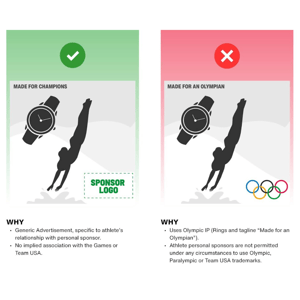
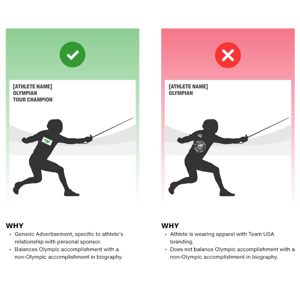
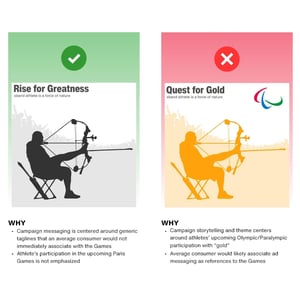
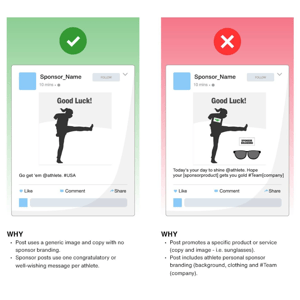
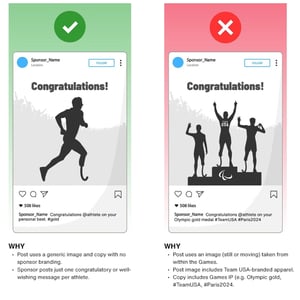
Why it Matters for Marketers
Rule 40 is about protecting official sponsorship rights. But it’s also about leveling the playing field. For non-sponsor brands, the opportunity lies in creative compliance: building authentic campaigns that champion athletes while staying within the lines.
The countdown to Milan-Cortina has already begun. If you want your brand to show up around the Games, the key is early planning, athlete partnerships, and a Rule 40 playbook you can trust.
About Parity, a Group 1001 Company
Parity is the leading platform for professional women athlete partnerships. With a mission to close the gender income gap in sports and beyond, Parity connects brands with a diverse network of more than 1,100 women athletes from 85 sports. Through sponsorship activations, content collaborations, and strategic advisory, Parity helps brands authentically engage the most trusted voices in sports today. For more information, visit www.paritynow.co, or follow us on Instagram and LinkedIn.



-1.png?width=600&name=What%20womens%20sports%20marketing%20campaign%20should%20you%20run%20in%202026%20(1)-1.png)
.png?width=600&name=Best%20Womens%20Sports%20Ads%20Blog%20banner%202025%20(1656%20x%20600%20px).png)